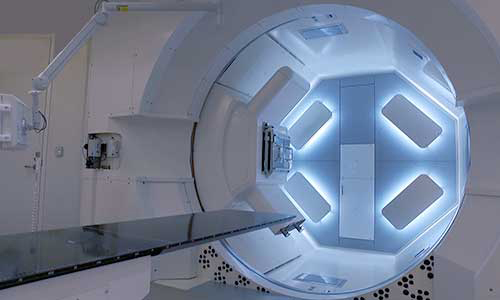Skull Base Chordoma
A chordoma is a form of bone cancer that can occur anywhere along the length of the spine, from the base of the skull to the lower back. When it occurs at the base of the skull, it is known as skull base chordoma. Because of its location in the base of the skull, it commonly affects vital structures. These include the nerves that control movement of the face, eyes, and swallowing.
Facts about skull base chordoma
Chordomas are rare cancers. Anyone can develop a chordoma at any age. But they are more common in older adults.
Types of skull base chordoma
Skull base chordomas are divided into 3 types:
-
Conventional. This is the most common type of chordoma. It is sometimes called a classic chordoma.
-
Chondroid. This type of chordoma has about the same outlook as conventional chordomas.
-
Dedifferentiated. The dedifferentiated form of chordoma is more aggressive. It grows more quickly than the other types.
Symptoms
If you have a skull base chordoma, the most common symptoms that you will experience are related to pain or changes in nerve function. These can include:
-
Headache
-
Face or neck pain
-
Double vision
-
Numbness in the face
-
Paralysis of the facial muscles
-
Speech changes
-
Swallowing problems
Diagnosis
Methods typically used to diagnose cancer will be used to identify a skull base chordoma. These may include different scans, such as X-rays, CT scans, or MRI. You may also have a blood test or a biopsy. Testing may be done by a specialist, such as a neurologist or a neurosurgeon.
It is common for a chordoma to be confused with (misdiagnosed as) another type of bone tumor called a chondrosarcoma. Both types of tumors can occur in similar places in the body. These tumors also look similar. Chondrosarcomas tend to respond better to radiation and have a better outlook.
Treatment
The primary treatment for a skull base chordoma is surgery to remove as much of the tumor as possible. This is often an aggressive procedure that can lead to some side effects. But it offers the best chance for long-term survival. You and your healthcare team should weigh the risks and benefits of the procedure before the surgery.
Once the surgery is done, an aggressive course of radiation therapy is used to kill the nearby tumor cells. Proton beam radiation is often used. It can focus on the needed area without exposing any critical organs and structures around it to radiation. Proton beam radiation offers the advantage of increasing the tumor dose while minimizing the dose to the nearby normal tissue. Other forms of radiation are sometimes used as well.
Chemotherapy typically doesn’t work well in treating a skull base chordoma. Currently, no medicines are approved for treating chordomas. But some have shown effectiveness in clinical trials.
Prevention
Skull base chordomas are rare disorders. It is not known how to prevent them.
Managing skull base chordomas
A skull base chordoma is a cancerous (malignant) and possibly life-threatening tumor. People need to be prepared for a difficult fight against the illness, one that will involve challenging treatments, such as surgery and radiation therapy. Even with treatment, these tumors often come back in the same area.
Outcomes from chordoma treatment have improved in recent decades. But it is best to address possible end-of-life issues as part of a skull base chordoma management plan.
The Johns Hopkins Proton Therapy Center

Proton therapy is used to treat certain tumors in children and adults. Our treatment center, located at Sibley Memorial Hospital in Washington, D.C., combines advanced proton therapy technology, the latest research and caring specialists.





